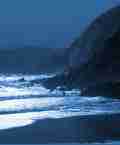 |

|
|||
 Saint Patrick's journey throughout Ireland brought him to the attention of pagan chieftain Laoghaire. Although Laoghaire remained a pagan, he was so impressed by the saint that he gave him permission to make converts throughout his realm. Muirchu's Life of Patrick, written two centuries later, describes a contest of magic in which Laoghaire's druids had to concede victory to the saint. Patrick travelled widely in Ireland, making converts and establishing new churches, though he eventually made his headquarters at Armagh. On one occasion he spent the forty days of Lent on a mountain in Co. Mayo which is now called Croagh Patrick. He was harassed by demons in the form of blackbirds, clustered so densely that the sky was black, but he continued to pray, and rang his bell to disperse the assailants. An angel then appeared to tell the saint that all his petitions for the Irish people would be granted, and that they would retain their Christian faith until Judgement Day. There are many legends about Patrick, not least that he banished snakes from Ireland and that he adopted the shamrock as a symbol of the Holy Trinity. Patrick's writings belong to the latter part of his life and confirm that he was less learned as a writer than he was persuasive as a speaker. Nonetheless, the Confession, a response to criticisms of his mission in Ireland, is a moving revelation of his vocation and of the divine guidance he received in dreams. Irish annals give the date of Patrick's death as 493, but an earlier date of 461 seems more likely. Tradition says he died at Saul and was buried at nearby Downpatrick. < < < Read the first part of this article
For more information on Saint Patrick and other Celtic Saints, the following Appletree Press titles are available:
|
All Material © 1999-2005 Irelandseye.com and contributors
